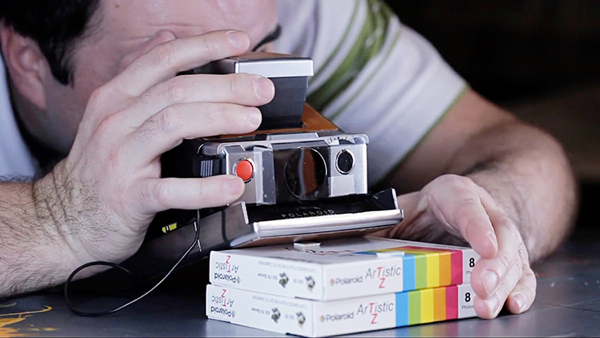Movie review by Greg Carlson
Lovers of “instant” photography can vividly recall their whereabouts in 2008 when Polaroid announced the end of integral film production. Integral film, the description commonly applied to the white-bordered prints that sandwiched all the chemicals necessary for development in layers, is synonymous with both inventor Edwin Land and the once powerful company he originally founded in 1937. Filmmaker Grant Hamilton’s “Time Zero: The Last Year of Polaroid Film,” artfully frames the digital versus analog struggle in clear and persuasive arguments about the things we lose when established processes are replaced by promises of the new and improved.
The first sections of the movie recount the monumental innovations of Land, and a number of the man’s colleagues share recollections of the inventor’s remarkable work habits. While a different story could have been told solely about Land, “Time Zero” avoids outright hagiography by broadening its scope to engage the art as well as the science behind Polaroid’s legendary history. Hamilton uses Arthur C. Clarke’s line that “Any sufficiently advanced technology is indistinguishable from magic,” and photographer Lou Noble, who has by his own estimate taken between four and five thousand Polaroid images, reiterates the oft-stated claim that Polaroid photography is akin to wizardry.
A significant portion of “Time Zero” explores the aesthetic and psychological appeal of Polaroid’s tactile, physical process, and some of the movie’s best moments belong to photographers like Tod Brilliant, who talks about how instant photography “transcends cultural boundaries.” Brilliant’s anecdote about presenting a Paris couple with the only photo they were going to see of themselves on the night of their wedding is one of several quicksilver illustrations of Polaroid’s unique immediacy and intimacy. Brilliant, Kim Van Groos, and many others make a mantra out of the power that resides in producing a physical artifact you can give to the subject just moments after exposure.
Graphic and industrial designers will salivate at any number of Hamilton’s sidebars. An interview with Polaroid art director Paul Giambarba, whose gorgeous, clean package design became one of the most distinctive brand identifiers during the company’s glory days, is a highlight. So too is the explanation by Barbara Hitchcock that Polaroid photography functions as a communication tool that “would make it easier for you, and everyone, to become an artist.” Not everyone, of course, likes the recognizable properties of a Polaroid photograph, but you won’t find any of those critics in Hamilton’s movie.
The final act of the film focuses on the efforts of the scientists and entrepreneurs affiliated with the Impossible Project, a labor of love undertaken by Florian Kaps and a few other dreamers who believed in a future for instant photography after Polaroid turned off their machines. Polaroid fanatics know that the Impossible Project is the only company in the world currently producing new film for the SX-70 and other automatic eject camera models, so the movie’s conclusion may be somewhat anticlimactic. That manufactured suspense, along with Hamilton’s decision to omit all but a passing mention of the still-popular-among-enthusiasts Land cameras that use peel-apart pack film, are minor complaints.
